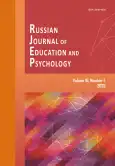Thinking styles as a gateway to effective language education
- Авторлар: Starodubtseva E.A.1
-
Мекемелер:
- Financial University
- Шығарылым: Том 16, № 1 (2025)
- Беттер: 97-113
- Бөлім: Educational and Pedagogical Studies
- ##submission.datePublished##: 28.02.2025
- URL: https://journal-vniispk.ru/2658-4034/article/view/300957
- DOI: https://doi.org/10.12731/2658-4034-2025-16-1-686
- EDN: https://elibrary.ru/CASWVN
- ID: 300957
Дәйексөз келтіру
Толық мәтін
Аннотация
Background. The relationship between thinking styles and language learning has long attracted the attention of scientists from various scientific fields. However, in recent years, this interest has become particularly relevant due to the development of the information space and multiculturalism. The need to revise traditional approaches to language learning is due to the qualitative changes occurring in the modern world.
The purpose of the present study is to actualize the concepts of interdependence between studying and learning a foreign language and different thinking styles.
Materials and Methods. In this work, a combination of quantitative and qualitative methods was used, namely, the use of questionnaires to determine thinking styles, including those developed by R. Bramson and A. Harrison, followed by interviews for a deeper understanding of the experiences of students with different styles, interviews, focus groups, observation, in-depth testing. All of this made it possible to obtain a complete and balanced picture of the influence of thinking styles on English language learning.
Results. The analysis showed that different thinking styles have a significant impact on foreign language learning. We found that different thinking styles, such as analytical, intuitive, creative, and others, have a significant impact on the choice and use of language tools. Differentiated methods for teaching professional English, based on accounting for individual thinking styles, were developed and tested. The proposed methods allow for the adaptation of educational materials to the cognitive characteristics of students. For learners with an analytical thinking style, tasks involving detailed analysis and systematization of information are most effective. Students with an intuitive thinking style can benefit from case studies and role-playing games that require quick decision-making. Creative students enjoy working on projects related to idea generation and unconventional solutions. Students with a logical thinking style tend to excel in tasks involving the construction of logical chains and data analysis. At the same time, it is important to combine various thinking styles in complex assignments, such as developing business cases where students with different thinking styles work in groups, allowing them to develop skills they may lack. The analysis of results demonstrates the necessity of considering individual thinking styles when studying a language and developing communication strategies. In the context of higher education, this topic allows for the development of more modern teaching methods based on the individual cognitive characteristics of students, which contributes to improving the effectiveness of the educational process.
Авторлар туралы
Elena Starodubtseva
Financial University
Хат алмасуға жауапты Автор.
Email: EAStarodubtseva@fa.ru
ORCID iD: 0000-0002-8031-3474
Cand. Sci. (Pedagogical), Associate Professor, Department of the English Language for Professional Communication
Ресей, 49/2, Leningradsky Prospekt, Moscow, 125167, Russian FederationӘдебиет тізімі
- Зимняя, И. А. (1991). Psychology of foreign language teaching in school. Moscow: Prosveshcheniye. 219 p.
- Карпов, А. В. (2024). Psychology of decision-making in professional activity: textbook for universities (2nd ed., corrected and added). Moscow: Yurait Publishing. 155 p. Retrieved January 12, 2025, from Educational Platform Yurait: https://urait.ru/bcode/538776
- Новикова, А. Н., & Федорова, С. Н. (2021). Accounting for learners' cognitive styles in choosing foreign language teaching strategies. MNIZH, (7-4). doi: 10.23670/IRJ.2021.109.7.125
- Холодная, М. А. (2002). Cognitive styles: The nature of individual mind. Moscow: PER SE. 304 p.
- Шифрон-Борейко, И. (2021). Influence of cognitive styles on choice of language acquisition and usage strategies. Vestnik VGPU, (3), 72–77.
- Юнг, К. Г. (2021). Psychological Types. Moscow: Harvest. 528 p.
- Bramson, R., & Harrison, A. (1986). The Art of Thinking. New York: Berkley Books. 224 p.
- De Bono, E. (1970). Lateral Thinking: Creativity Step by Step. New York: Harper & Row. 300 p.
- De Bono, E. (1985). Six Thinking Hats. Boston: Little, Brown and Company. 192 p.
- Kolb, D. A. (1984). Experiential Learning: Experience as the Source of Learning and Development. Englewood Cliffs: Prentice-Hall. 256 p. Retrieved January 12, 2025, from: https://www.csulb.edu/sites/default/files/document/kolb_d._a._2014._experiential_learning-_experience_as_the_source_of_learning_and_development._ft_press.pdf
- Messick, S. J. (1984). The nature of cognitive styles: Problems and promise in educational practice. Educational Psychologist, 19, 59–74. https://doi.org/10.1080/00461528409529283
- Myers, I. B., & Briggs, K. C. (1980). Gifts Differing: Understanding Personality Type. Palo Alto: Consulting Psychologists Press. 228 p.
- Sternberg, R. J. (1985). Beyond IQ: A Triarchic Theory of Human Intelligence. Cambridge: Cambridge University Press. 411 p.
- Sternberg, R. J. (1997). Thinking Styles. Cambridge: Cambridge University Press. 192 p. https://doi.org/10.1017/CBO9780511584152
Қосымша файлдар










